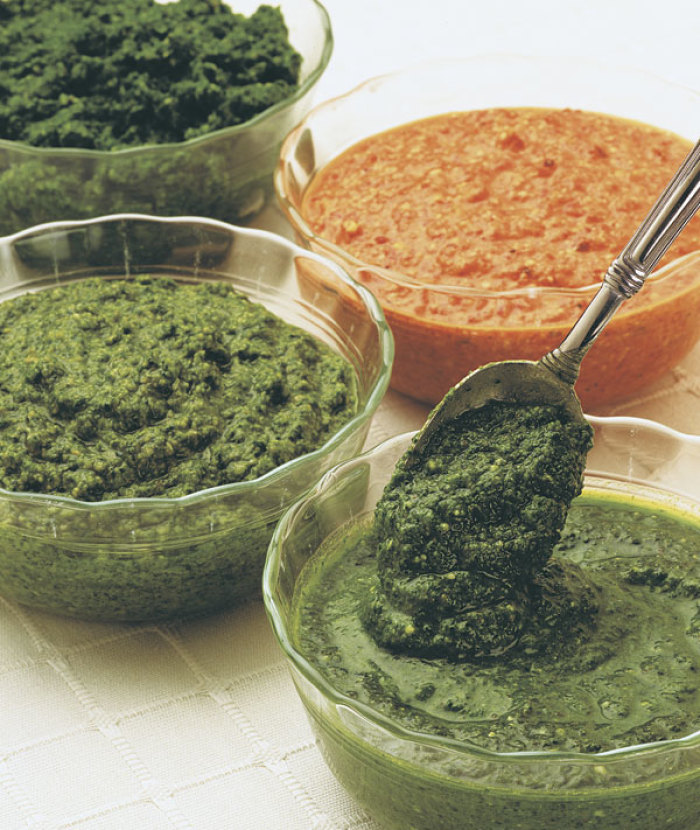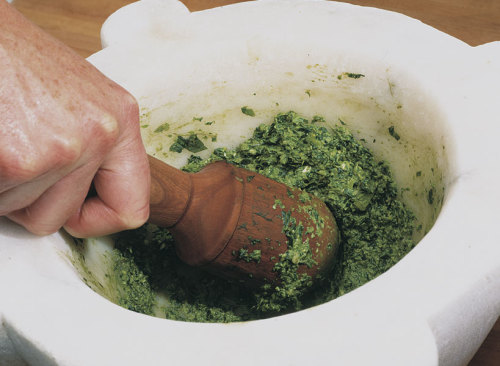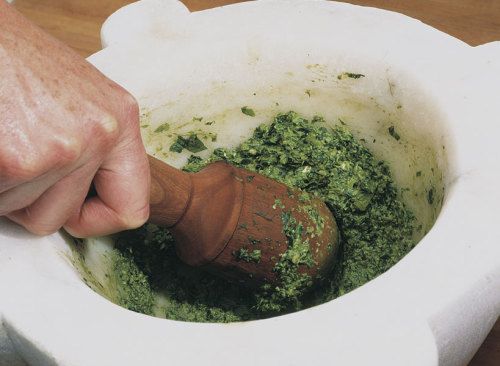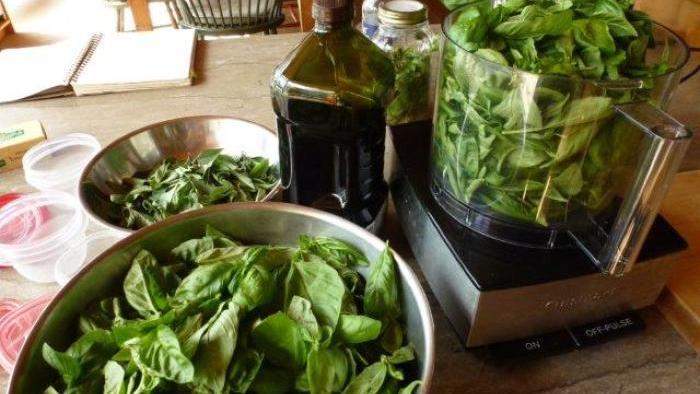
by Steven Van Yoder
February 2000
from issue #25
When the interest in Italian food exploded in the early 1980s, pesto—the classic, uncooked Genovese sauce made from basil, garlic, and pine nuts—began working its way into our kitchens and onto our plates. What 20 years ago was ethnic, exotic, and earthy has become an American favorite. Traditional pesto has always had one great role for Genovese cooks—to be the most seductive of all sauces for pasta. But in America, the rich green sauce that has dressed a million plates of noodles is getting a makeover.
 |
|
| Pesto can be as varied as the herbs in your garden. In the photo, a quartet of unconventional mixtures includes (front to back) Tarragon and Hazelnut Pesto, Sage and Roquefort Pesto, Spicy Red Pepper Pesto, and Pacific Rim Pesto. | |
Pesto can be made with many different herbs besides basil, and with other nuts and cheeses. As for putting it to use, it can top meats, fish, vegetables, and pizzas; boost the flavor of soups and salad dressings; or be a pungent spread for sandwiches. And pesto is flexible and forgiving. With a handful of ingredients, a blender or food processor, and a creative attitude, you can concoct pesto sauces that can transform a run-of-the-mill dish into an exciting meal in minutes.
How to make traditional basil pesto
Traditional basil pesto originated in Italy several centuries ago. In the region of Liguria, a narrow crescent of mountains, vineyards, and ancient fishing villages that borders the Mediterranean, basil is omnipresent, spilling from windowsills, balconies, and flowerpots. The monks who still live there cultivate wild herbs on the hills behind the monasteries, producing magnificent pestos and other herb sauces.
Liguria is a seafaring region, and its culture and food have been shaped by the ocean. Ligurian fishermen would go out for long periods of time, and needed foods that could last the voyage. Ligurian women made pots of herb sauces that would store well, if covered in oil to keep out the air. The pungent paste, made from local ingredients, imparted the flavors of home to fish, pasta, and dried bread—foods that otherwise would have been pretty bland. (Incidentally, ravioli was also invented in Genoa with the seafarer in mind: leftover ingredients were folded into pasta squares and dried, thus preserving them for long voyages.) Ligurian sailors ate pretty well while at sea; the men could boil pasta, open a pot of pesto, and enjoy a flavorful meal.
Every village in Genoa has its own pesto recipe, some with pine nuts, some with fennel, some with basil, some with Parmesan or pecorino or ricotta cheese. But the goal is always the same: to have the most fragrant pesto possible. The origin of the word pesto is the verb pestare, which means to pound, as with a pestle. In Genoa, that’s the only way to make pesto—you gradually grind the ingredients to a rough paste, bringing out their fragrances in the process (photo, above). Pesto made in a machine is similar, but has a smoother texture.
Basic pesto techniques
 |
|
| Making pesto with a large, heavy mortar and pestle like the ones shown here takes about seven minutes. With a food processor, it takes about one minute. | |
A mortar and pestle may be the orthodox method for making pesto, but for the sake of convenience, you can’t beat a food processor or a blender. A food processor is the better machine to use, but a blender certainly works. With a blender, you will have to add some or all of the oil along with the herbs to get them puréed.
The key to great pesto lies in using the best possible ingredients. Herbs should be absolutely fresh. Swish them in cold water to get rid of any soil, then pat them dry or spin them in a salad spinner. Good oil is critical; use a fruity, green, extra-virgin olive oil. The same goes for cheese. Buy the highest quality cheese you feel you can afford.
For added flavor, I often toast the nuts first, putting them in a medium oven (300° to 350°F) until lightly browned, which takes 5 to 10 minutes. I check them midway through, giving the pan a quick shake. When I make Pacific Rim Pesto, I prefer the nuts untoasted, to keep the flavors clean and bright.
If I’m using a strongly flavored herb like sage, tarragon, or oregano, I blend in mild greens like parsley and spinach to tame the intensity of the herb. Four to five parts mild greens to one part powerful herb seems to work best. You might prefer it stronger or milder. In fact, most of the ingredients in pesto can be jiggered to suit your taste. Just how much oil you need depends on how you plan to use the pesto. For a sauce suitable for dressing pasta, you’ll need it fairly soft and creamy. For spreading on pizza or sandwiches, or for adding to soups, sauces, and vinaigrettes, a drier pesto will do.
Pesto is at its fragrant best immediately after being made, but it will store for several days in the refrigerator if you cover it with plastic wrap or a thin layer of olive oil to prevent discoloration. Pesto can be frozen for longer storage, although it will lose some flavor. If you plan to freeze it, withhold the cheese and nuts until serving, for a better texture.
Your own pesto adventure
If you build on the foundation of classic pesto—a fresh herb, nuts, and olive oil— it’s easy to come up with a new generation of sauces, which can be used in many ways to enhance all kinds of foods.
If you’re just starting to experiment with new pesto variations, it’s helpful to keep a regional theme in mind. Greek pesto might be made with feta cheese and mint, southwestern pesto could include pumpkin seeds and roasted chiles, a Scandinavian-inspired pesto sauce could be based on fresh dill. Once you’ve gotten your wings, try adding more adventurous herbs to your mix, like lemongrass, watercress, arugula, and pungent greens like mustard. Experiment with different cheeses and nuts.
Pasta is still a great vehicle for enjoying pesto of all kinds, but there are dozens of other ways to put your savory paste to work. Use it as a spread on burgers and sandwiches, add a spoonful to sauces, vinaigrettes, soups, and scrambled eggs, or use it as a filling for omelets. Toast slices of country bread and spread them with pesto for a quick appetizer. Put a dollop on grilled meats or fish fresh off the fire, and let the heat soften and spread the pesto into a sauce. Smear a couple of spoonfuls over pizza dough before topping with vegetables and cheese. The list could go on and on.
Here are a few recipes to get you started on non-traditional pestos:
• Spicy Red Pepper Pesto
• Sage and Roquefort Pesto
• Tarragon and Hazelnut Pesto
• Pacific Rim Pesto


















Comments
Log in or create an account to post a comment.
Sign up Log in